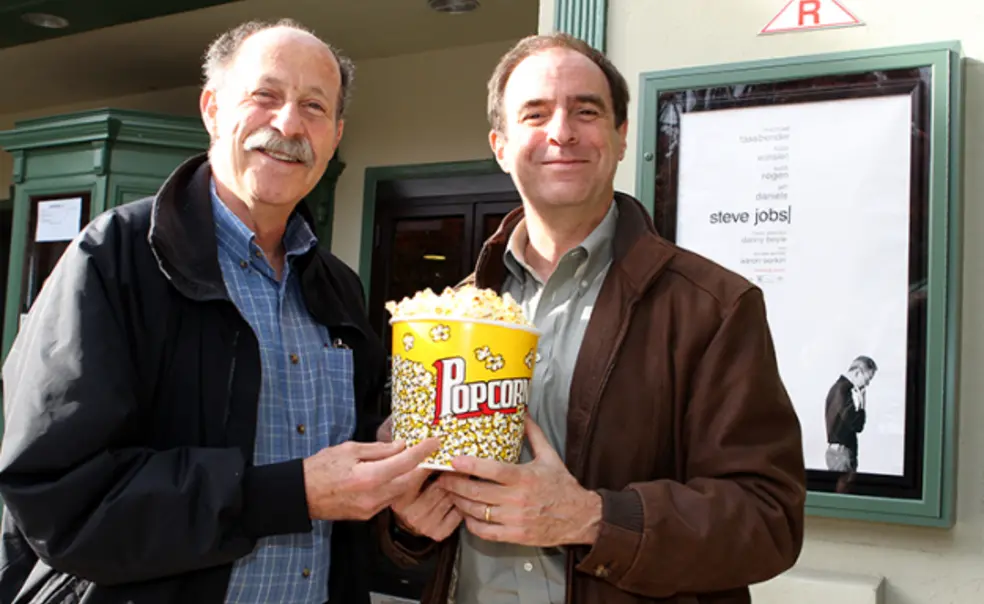PAW Goes to the Movies: ‘Steve Jobs,’ with Professor Michael Littman
When the history of our time is written, will Steve Jobs be remembered as one of the world’s great innovators? The Apple co-founder and CEO, who died in 2011, is the subject of a new movie, aptly titledSteve Jobs, which focuses on the rollout of three of his most significant products: the Macintosh in 1984, the NeXT in 1988, and the iMac in 1998. The film, which was written by Aaron Sorkin and directed by Danny Boyle, stars Michael Fassbender as Jobs and Kate Winslet as Jobs’s longtime marketing assistant, Joanna Hoffman.
In another installment of our periodic series, PAW Goes to the Movies, senior writer Mark F. Bernstein ’83 invited Michael Littman, a professor of mechanical and aerospace engineering, to evaluate Jobs the movie and Jobs the man. Littman teaches a class, “Engineering in the Modern World,” that includes study of Jobs, Bill Gates, and the development of the personal computer. He also teaches a course on automation in which students design the equivalent to the original Apple I computer.
MFB: This was a movie written and directed by non-engineers. Did they get the science right?
ML: I think they got it right. If I were to give it a grade technically, I would give it high marks.
MFB: Was there anything you didn’t like?
ML: The movie presented Jobs as a very skilled marketer, but I don’t think it emphasized his skills as a designer enough. Jobs developed the Graphical User Interface for the Macintosh, and it changed the face of computing. That technology was basically pirated from Xerox. Xerox could have developed it, but they didn’t have the business skill to recognize what they had. So what if Jobs stole it? He was the one who introduced it to society. Henry Ford didn’t invent the automobile, but he was the one who developed it.
In my course, we define innovation as invention plus entrepreneurship. One without the other won’t go very far. At Apple in the early years, Steve Wozniak was the inventor and Jobs was the entrepreneur. Only a few rare individuals, such as Thomas Edison, can do both.
MFB: The film doesn’t mention Jobs’ later successes with the iPod, iPad, or iPhone. Or his illness. Did that surprise you?
ML: That was smart. Less is more. If you want to make a lasting impression, don’t cover his life from beginning to end. Fifty years from now, we don’t know what people will think of as Jobs’s greatest contributions. Where will Apple be without him? It was smart of the screenwriters to stop where they did.
MFB: Some have suggested that it is not possible for lone inventors to thrive anymore, that most technological breakthroughs are collaborations. Do you agree?
ML: I reject that view. Look at the people we hold up today as having changed the world: Jeff Bezos [’86]. Mark Zuckerberg. Bill Gates. Steve Jobs. It’s individuals. If you look at successful enterprises, there is usually a driven individual who has an idea and won’t let it go. Ford had that vision. Jobs had that vision. I believe Bezos and these others had it. The reason the individual is so important is because the complex parts of the big picture come together in one mind. A visionary individual can do that better than a team. So in that respect, I don’t think we’re in any different place today than we were 100 or 200 years ago.
MFB: Has the pace of technological innovation gotten faster?
ML: Imagine the pace of change between 1890 and 1930. You saw the development of electricity, oil, steel, airplanes, automobiles, telephone, radio. To say that we’re in a new place in the Information Age misstates things. The pace of change today is fast in some areas — such as information — but in other areas, such as energy and transportation, it is not.
MFB: How do you compare Jobs and Gates?
ML: One thing they have in common — though I don’t like to emphasize it — is that they’re both college dropouts. Also, neither really was responsible for any singular technical innovation. Gates took the BASIC computing language [qBASIC], and a disk operating system [MS-DOS] pirated from the Digital Equipment Corporation [DEC] and imported it to the IBM machine. Later he stole the user interface pioneered by Jobs to create Windows. Jobs, too, was very good at taking ideas that others had conceived and developing them. He was a visionary salesman, and he had an artist’s eye for design. Both men were brilliant in their own way. And both were the beneficiaries of a certain amount of luck, too. I think any of these entrepreneurs would tell you that they had the right idea at the right time.
MFB: Does Jobs belong in the pantheon of world-changing innovators?
ML: I think that Jobs’ presence will be felt in perpetuity, maybe even more so than Gates’. I think he is of a stature of an Edison or a Ford, but he won’t be in the pantheon alone. When it comes to the development of computers, Alan Turing [*38] also belongs on the list. John von Neumann, who taught at Princeton and developed the binary computer, is another.
MFB: Twenty years ago, Microsoft was the iconic computer company. Where are they today?
ML: We just had a job fair over at Dillon. Microsoft had a booth there and so did Google and Facebook. The Microsoft booth got some visitors, but the others were swamped. I think it’s clear where this generation of college students thinks the action is. Follow the young people.












No responses yet